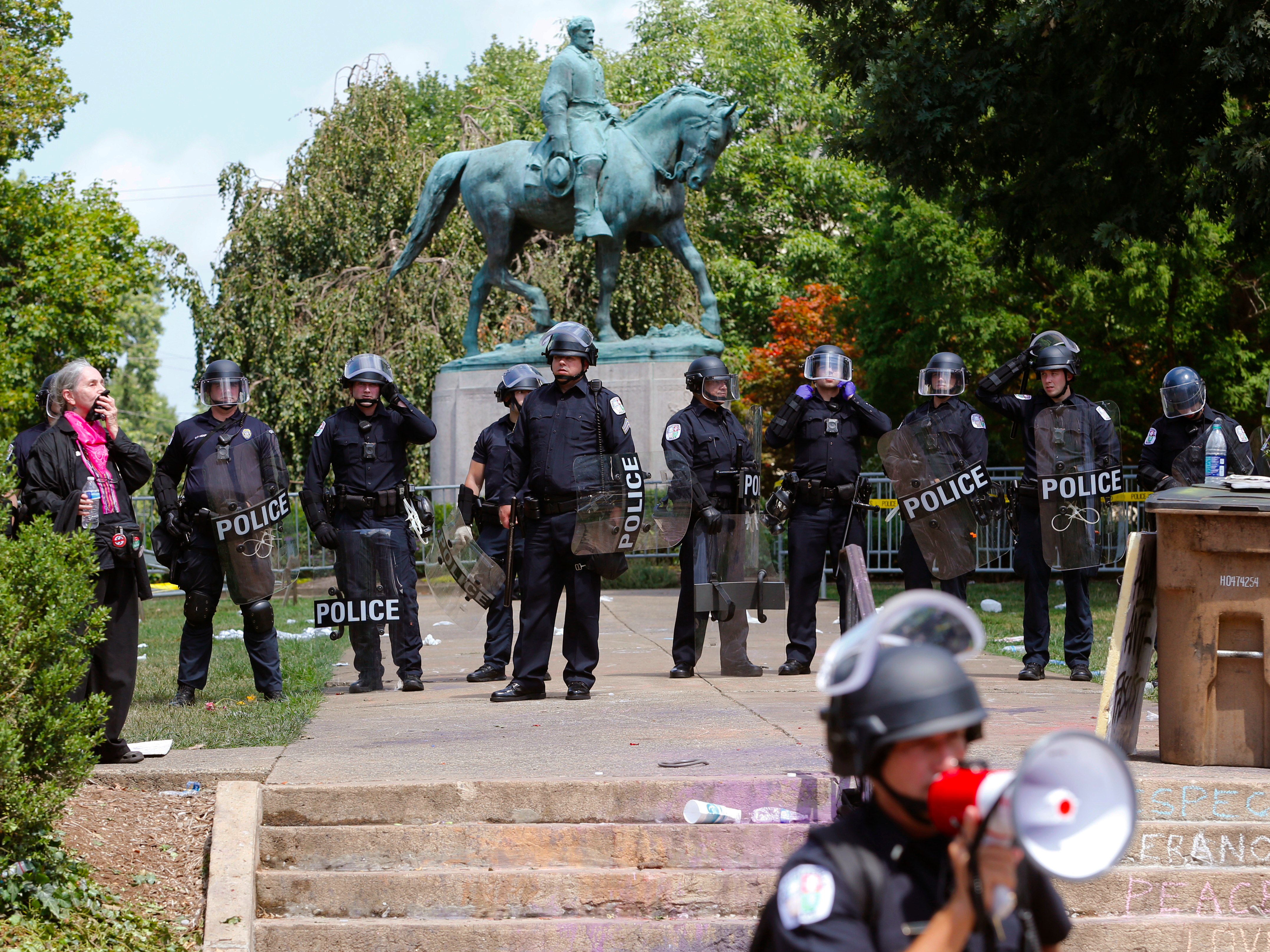• Donald Trump held a controversial press conference Tuesday, in the aftermath of a deadly white nationalist rally in Charlottesville.
• He blasted the push to remove Confederate statues – sentiments he reiterated Thursday via Twitter.
• Most Confederate statues were erected decades after the war ended.
• Such monuments are potent symbols for the entrenched “Lost Cause” ideology, which serves to defend the Confederacy.
US President Donald Trump took to Twitter Thursday morning to blast the push to remove Confederate statues from public spaces, saying: "Sad to see the history and culture of our great country being ripped apart with the removal of our beautiful statues and monuments."
His latest series of tweets echoed the sentiments he expressed in his controversial Tuesday press conference. After a deadly protest erupted in reaction to the planned removal of a statue of Confederate Gen. Robert E. Lee from a park in Charlottesville, Trump drew a connection between Lee and American founding father George Washington.
"So this week it's Robert E. Lee. I notice that Stonewall Jackson's coming down," he said. "I wonder: Is it George Washington next week, and is it Thomas Jefferson the week after? You know, you really do have to ask yourself where does it stop?"
Confederate statues have a complicated history.
The majority were erected between the 1890s and the 1920s, at "the height of Jim Crow, of state-sanctioned segregation, disfranchisement, and lynching," Purdue University history professor Caroline Janney told Business Insider.
For the most part, the hundreds of Confederate statues that cropped up from around the US were erected as political props. And they're clearly continuing to have an impact on public discourse.
Here's a brief history of statues like the patina-coated, equestrian portrayal of Lee that led to three deaths in Charlottesville:
Pretty much all historical statues, busts, and monuments are propaganda.

When we commemorate historical happenings and figures in public spaces, we are essentially telling future generations what should matter to them and who they should hold in esteem.
Popular opinion changes. Historical heroes rise and fall. History isn't static. This is normal.
But to decry these shifts as changing "history" and "culture" represents a misunderstanding about what these statues are.
Numerous commentators have already pointed out that Trump's comparison of slave-holding Founding Fathers like George Washington and Thomas Jefferson and Confederate icons is problematic. The attempt to lump these figures together feels more like historical "whataboutism" than anything. "Some figures stood for something larger," NPR's Steve Inskeep says.
"I don't think there's much chance of history being wiped away, and these statues don't represent that anyway," College of William and Mary history professor James Whittenburg told Business Insider.
The Confederate monuments in particular represent an attempt to influence how we view a movement which sought to break up the US and establish a new nation based on slavery.
So how did the losing side of a war fought 152 years ago come to establish a publicity campaign so successful that they erected states in 33 states, including D.C.? Why, in 2017, does the US president feel the need to defend their long-dead military leaders?
Thank the Lost Cause movement.
The monuments further the post-war narrative of the 'Lost Cause.'

"The Lost Cause was a story former Confederates crafted to present their cause in the best possible light," Janney says.
That effort consisted of three basic tenets, according to Janney:
1. The South lost the Civil War due to superior Union resources and military power, not because of the decisions of military and political leaders like Lee and Confederate president Jefferson Davis. And certainly not because they were wrong.
2. Secession was constitutional.
3. Slavery was not the cause of the Civil War.
But while this ideology started early - promoted by former Confederate generals like Jubal Early - the statues didn't crop up right after the war.
Immediately after the Civil War, efforts to commemorate Confederate soldiers in the South focused on mourning and burying the dead.
Soon enough, however, "... public monuments became a central means of rewriting history from the Confederate perspective - 'righting history,' their patrons said," writes Cynthia Mills in "Monuments to the Lost Cause."
"They come in waves," Whittenburg said. "When there's a perceived threat to the South or within the South."
The Southern Policy Law Center's 2016 report on Confederate commemoration highlights this nicely. The peak of public Confederate iconography occurred in 1911 - 46 years after the end of the war, but only two years after the founding of the NAACP.
Other, less sharp spikes occurred after race riots in the 1920s and during the Civil Rights movement of the 1960s.
Whittenburg said the monuments tend to come from attempts by the political and business elite to "re-enforce or reinvigorate their claim to authority."
"They manipulate the memory through statues and other symbols," he added.
Lee, whose statue sparked the violence in Charlottesville, was personally not a proponent of Confederate memorials, according to ABC. Still, he is a popular subject of Confederate statues.
Whittenburg says that in the years after the war, Lee proved to be a powerful figure of reunification for white Southerners and white Northerners. But first, Lee had to be "cleansed of slavery and treason" in the public perception, according to Whittenburg.
So Lee's personal virtues and military prowess have been overemphasized, at best, and his connection to slavery has downplayed over time - despite his own status as a slave owner.
The cleansing worked.
"After he died, Lee was a hugely popular figure in the North as well as the South," Whittenburg said.
The Lost Cause has lost some power over the years.

Today, the acceptability of commemorating Confederate figures and what they stood for in public spaces has been increasingly called into question.
After all, these statues are mostly products of a time marred by "extreme racial violence, as Southern whites pushed back against what little progress had been made by African-Americans in the decades after the Civil War," writes Karen L. Cox in the New York Times.
If anything, the violence in Charlottesville has just spurred different locales to speed up the removal of this controversial statuary.
As a result of this shift, the statues have morphed into political lightning rods.
"They're serialized symbols," Whittenburg says. "They pop up every once in a while when there is controversy and they become rallying points."
Today, they've become rallying points once more. An emboldened coalition of white nationalists has latched onto the issue of the monuments.
"The important thing is what they mean now," Whittenburg said. "I think Trump probably sees what they mean now, pretty clearly."

